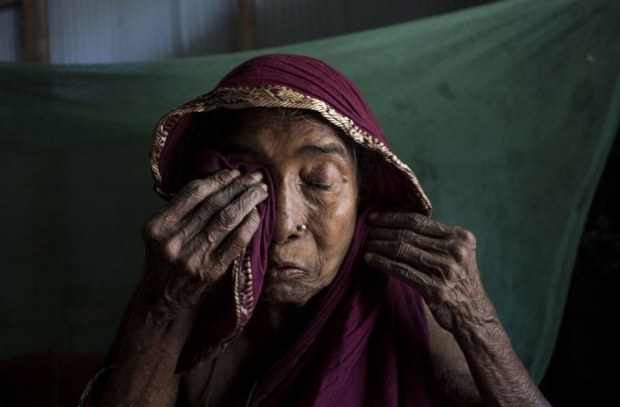20 Million Bangladeshis Exposed to Arsenic-Laced Water: Report
2016.04.06
Dhaka
 Anuwara Begum cries while remembering her son-in-law, a farmer who died from arsenic-related illnesses, during an interview with Human Rights Watch in the village of Iruaian, Laksam Upazila, in Bangladesh’s Comilla district, March 5, 2016.
Anuwara Begum cries while remembering her son-in-law, a farmer who died from arsenic-related illnesses, during an interview with Human Rights Watch in the village of Iruaian, Laksam Upazila, in Bangladesh’s Comilla district, March 5, 2016.
Updated at 3:43 p.m. ET on 2016-04-06
Twenty million Bangladeshis drink arsenic-tainted water, but the government is failing to protect their supply from the chemical that can cause cancer and other illnesses, a new report by Human Rights Watch (HRW) says.
An estimated 43,000 people in the South Asian country die annually from sickness related to drinking water laced with naturally occurring arsenic, according to a study cited in HRW’s report, which came out Wednesday. The figure of 20 million equals about 8 percent of Bangladesh’s population of 150 million.
“Bangladesh isn’t taking basic, obvious steps to get arsenic out of the drinking water of millions of its rural poor,” said Richard Pearshouse, a senior researcher at HRW and author of the 73-page report titled “Nepotism and Neglect: The Failing Response to Arsenic in the Drinking Water of Bangladesh’s Rural Poor.”
“The government acts as though the problem has been mostly solved, but unless the government and Bangladesh’s international donors do more, millions of Bangladeshis will die from preventable arsenic-related diseases,” Pearshouse said in a statement prepared ahead of the report’s release.
However, the director general of Bangladesh’s Health Department questioned the accuracy of the 20 million figure contained in HRW’s report, which was released at a news conference in Dhaka.
“It is not very clear to us from where and how HRW got this number. They didn’t communicate with us,” Dr. Deen Mohammad Nurul Haque told BenarNews.
Traces of the chemical can be found in water pumped by hand from mostly shallow tube wells scattered across rural Bangladesh, HRW said in a news release that accompanied the report’s official release in Dhaka.
In preparing its report, HRW said it interviewed 134 people, including residents of several villages that suffer from arsenic-linked health problems, government officials and caretakers of government wells installed in five villages.
The five villages are scattered in different regions of the country. They include Balia, a village in Barisal district, in the south; Iruain, in the southeastern district of Comilla; Ruppur in Pabna district, in the northwest; and Bilmamudpur and Tilchandi, in the central districts of Faridpur and Narayanganj.
HRW also studied data related to some 125,000 government water points that were installed between 2006 and 2012. Yet nearly 20 years after the problem of contamination of groundwater across much of rural Bangladesh by naturally occurring arsenic drew international attention, 5 percent of wells reviewed by HRW in its analysis of data were contaminated above the national standard.
Following an international conference in Kolkata, the capital of the neighboring Indian state of West Bengal, Bangladesh along with international donors and NGOs began a concerted in the late 1990s to combat the problem of groundwater contamination, “but the urgency of such efforts has dissipated” since 2006, HRW said.
‘All about politics’
Complicating the problem is a lack of quality control in arsenic-mitigation projects, compounded by a pattern of some politicians at the local and national levels diverting projects for new wells to their supporters and allies, according to HRW.
“Site selection of new tube wells is essentially all about politics,” the report quoted an anonymous government official as saying.
“They give them to their political allies, their supporters, those close to them or those who work for them. It is very frustrating, they don’t consider the real needs of the people.”
Khaddro, a farmer in Ruppur village, told HRW that “many government tube wells” were “installed in private homes.”
“[T]he owners bribe government people or use their political connections,” Khaddro said. “We don’t even know where some of them are, they’re so secretive. It makes me very angry to think about this.”
Responding to the HRW report, Shirin Akhter, chairman of the Union Parishad in the Fakirpur sub-district of Baghabari district, said a high demand for well tubes had made it difficult to provide people with enough wells.
“The fact is there are too many applicants for one deep tube well. The supply is not enough for our needs. So it is quite impossible to make everybody happy,” Akhter told BenarNews.
Shahriar Sharif in Dhaka contributed to this report.







